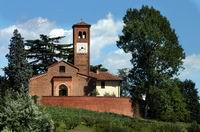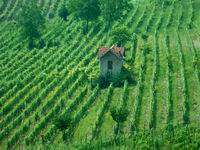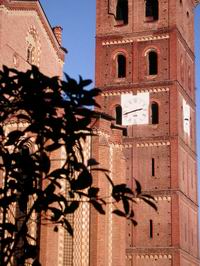|
HISTORY
The development of this area dates back to this period with the town of Asti in the centre, already a lively commercial centre.
The strategic position of the town is one of the reason for the great power and wealth of Asti in medieval times. Between the 11th and 14th centuries the free commune of Asti was one of the strongest and richest in northern Italy and it extended its territories by fighting the other great power in this area, the Marquisate of Monferrato. Evidence of this rich and stormy period is provided, in the town of Asti, by the towers, fortifications, the splendid gothic cathedral, the collegiate church of San Secondo, the crypt of Sant'Anastasio and the original historical centre urban plan, and in the province by castles, bastions and fortified settlements built for strategic requirements by one or other force in power.
The easy connecting roads mean that Christianity reached the area at an early date and therefore there is a great deal of religious heritage. The Asti province is crossed by Via Francigena, a complex of routes followed by pilgrims heading for Rome. In the tracks of these routes, it is possible to visit the romanesque churches, following a very suggestive itinerary, also from the landscape point of view. It is also possible to visit the abbey of Vezzolano, one of the stops on these medieval pilgrim-ages, as well as the complex of San Pietro in Asti.
With the end of the Middle Ages, bloody battles began in the 16th century for the succession of the Marquisate of Monferrato which damaged many castles and changed the political make up of the area. Once Monferrato was pacified under the Savoia dynasty, many forts became elegant 17th century castles and many fortifications in Asti became sumptuous aristocratic buildings.
Romanesque, gothic and baroque styles often live side by side in this area, but always harmoniously and never out of place. Where castles were destroyed by war, between 1600 and 1700, majestic baroque parish churches were built, often of imposing size with respect to the villages, often containing works of artists such as Guglielmo Caccia, known as "Moncalvo", mannerist painter who lived in Asti and whose churches are real art galleries of his school.
There are still other aspects to point out, for example places connected to famous people, such as San Giovanni Bosco. His sanctuary at Castelnuovo Don Bosco is a gathering place for pilgrims from all over the world.
In Asti everything reminds us of the greatest 18th century dramatist: Vittorio Alfieri, who was born here in 1749.
ITINERARIES
North ...
The northern part of the Asti region offers various itineraries. Following the direction of Chivasso along the old roman road one can travel along the traced route of the Via Francigena, the medieval journey of the pilgrims arriving from Rome: to do this simply follow the indications for the many roman churches, which remain as testimony of these passages. Cortazzone, Montechiaro, Montiglio, Cerreto, Montafia, are only some of the villages, which, usually, just outside the built-up areas, on green hills or near little cemeteries, host these small churches, which have nearly all been renovated and can be visited. Worthy beginning and end of this itinerary is the visit of the Abbey of Vezzolano, the most important Romanesque monument of the Piedmont.
Another antique road (which interlaces with the first) is the Valle Versa road, with its castles: Castell'Alfero, Montiglio, Frinco, Rinco and further up Passerano until one reaches Cocconato, balcony on the Monferrato, with its beautiful old town centre. Those choosing a more religious journey can head for the “Terre dei Santi” (Land of the Saints): Calstenuovo Don Bosco and its surroundings, where San Giovanni Bosco, San Domenico Savio, the Blessed Cafasso and Cardinal Massaria where born. Towards east lay the gentle hills of the heart of what used to be the great Marquisate of the Monferrato: the itinerary, which leads from Portacomaro towards Moncalvo, the smallest city in Italy, offers splendid historic testimonies such as the Castle of Montemagno, Romanesque art, the manieristic paintings of the Caccia in the parish churches and, from the point of view of landscape and oenology, also the larges vineyard of Italy.
A last suggestion are the ethnography museums: from Cisterna (nearby the historic town centre of San Damiano) to the sites of the Ecomuseo, to the Plaster museums of Montafia and Moncucco, there are many opportunities to learn more about the farm life of the Lower Monferrato.
South...
The southern part of the Asti region is where the grape cultivation is most important and characterizes the landscape.
There are many suggestions for tours in this part of the Monferrato south of the river Tanaro. First of all the oenological routes: there are numerous museums dedicated to the Wine and its production today and in the past  (Costigliole, Mombercelli, Nizza Monferrato are only a few of the hosting towns), exceptional are the historical cellars of Canelli, the capital of the Moscato and the Asti Spumante, true underground cathedrals. (Costigliole, Mombercelli, Nizza Monferrato are only a few of the hosting towns), exceptional are the historical cellars of Canelli, the capital of the Moscato and the Asti Spumante, true underground cathedrals.
But first of all the vineyards, as far as the eye can see, which in autumn turn to thousands of different colours. For nature lovers there are many possible excursions to the parks and nature reserves of this area, in the Valle Sarmassa, in the woods of Rocchetta Tanaro, on the bank of the river Bormida in Sessame to observe the herons which have returned to populate the banks of these rivers.
For the lovers of history there is no lack of cues: from the castle of Costigliole to the one in San Martino Alfieri, from Calamandrana to Calosso, castles and country houses full of memories from medieval times to the Risorgimento.
And there is yet to discover the south-east around Mombaruzzo, famous for its Amaretti sweets, but rich in noble palaces and prestigious buildings besides many, many vineyards. And then, on the most southern point of the province, where the vineyards end and the hills rise higher, the landscape turns rough and yet more suggestive: the Langa of Asti with its medieval watch towers against the Saracen invasions in Cassinasco, San Giorgio Scarampi, Olmo Gentile, the “double” church of Cessole, suggestive remains of the castles and Roccaverano, the highest village in province at almost 800 m. elevation, with its bramantesque parish and the breathtaking panorama.
Asti
Capital and heart of the province, Asti is with its 73,000 inhabitants a city on a human scale. Famous all over for its wines and its cuisine, and maybe less, wrongly so, for its beauty on an artistic level, it must be discovered by foot, strolling in its old city centre, which has maintained the medieval urban structure.
 The medieval period, with its great richness and power, has left splendid traces in the main monuments of the city, the Cathedral, the Collegiate of San Secondo, the complex of San Pietro in Consavia, in the towers and particularly in the town houses and streets. The baroque stile of its noble mansions and the XIX century elegance of its squares manage to become one without any false notes, creating a harmonious whole with the elegant windows of the Liberty shops. The medieval period, with its great richness and power, has left splendid traces in the main monuments of the city, the Cathedral, the Collegiate of San Secondo, the complex of San Pietro in Consavia, in the towers and particularly in the town houses and streets. The baroque stile of its noble mansions and the XIX century elegance of its squares manage to become one without any false notes, creating a harmonious whole with the elegant windows of the Liberty shops.
Asti, bound to its magnificent past, which comes to life each year on occasion of the Palio, Asti lively and busy in its weekly markets, Asti rich in cultural and oenogastronomic events, which make a stop in this town even more agreeable.
ENOGASTRONOMY
The province of Asti is especially renowned for its wines, which have made it famous all over the world. Its beautiful hills are very characteristic with vineyards, which cover the majority of the slopes.
The range of Asti's DOC and DOCG wines includes various types from white to red, sweet to dry, lively to sparkling, with the potential of accompanying a complete menu from the starter course to the dessert course. From the Famous reds such as Barbera d'Asti, the production of which is widespread all over the province, to the smaller typical productions of Rouchè, Albugnano or the late harvest Loazzolo wine, the wines of Asti complete the wide gastronomic range available in the territory.
Alongside its wines, the local cuisine is synonymous of traditional and quality. The local recipes are all based on ancient recipes, which are still today proposed by the most famous restaurants of the province. Of these the leader is the Bagna Cauda (a simple, savoury sauce made with oil, garlic and anchovies, especially imported from the Ligury region since Medieval times) to be tasted with the well-known "square" red peppers of Motta di Costigliole, the "cardo gobbo" (a local type of artichoke) from Nizza Monferrato and the vegetables from the valley of the River Tanaro.
Rich and varied is the choice of starter courses prepared with the seasonal produce, whilst the regality of the first courses goes to the agnolotti, the acclaimed filled pasta of which the ingredients can vary slightly from town to town. For example at Calliano the agnolotti would be filled with donkey meat, at Viarigi, with rabbit and at Costigliole you would be served with the plin variety (closed with a pinch). At Cessole, the agnolotti are served directly in the napkin and without any sauce. Wherever you taste them, they are served with a sage and butter dressing that exalts the taste of the excellent Piedmont bovine meat. Typical and ancient dishes enrich the menus of many restaurants, who pay particular attention to tradition: in this way is possible to savour both the finanziera and the fritto misto, two "heritage" dishes of the local country cuisine born to use the meat giblets. Other dishes with "exotic" names are the tartrà (basilcally a vegetable soufflè) and the fricandò a dish of meat cooked in a local sauce.
The winter menus are rich with cheese fondue sauces, aromatised with mushrooms and with the precious white truffles of the Monferrato area. The start of the cold season sees the introduction of different boiled meats.
The Spring and Summers menus have, as their mainstay, the reputed "fruits" of the land such as the Saracen asparagus of Vinchio, red and green peppers and vegetables of all colours, that are served with dishes of rabbit and chicken.
The wines are accompanied by cheeses and cold meats; the esteemed "robiola" cheese of Roccaverano, a goat's cheese made with an ancient recipe which gives it a rich taste, thath changes with the season according to the type of grass on the high Langhe Asti hills. This is served with honey or fragrant mostard (a sauce of grape must, hazelnuts and fruit). Among the cold meats, we must remember the salame cotto (cooked salame), and the original production of salami made with donkey meat and Cocconato ham.
Land of Moscato and Asti Spumante certainly does not lack the desserts to accompany these wines. The list is very long but we would invite you not to miss the excellent bùnet, the peaches with chocolate filling and the Moscato zabaione (egg nog). If you decide to take home one of the local choice desserts, do not forget the torrone (a type of home made nougat), the polentina (a special sweet cake with almonds, currants and maraschino liqueur), the astigiani al rhum (rum filled chocolates), le torte del Palio (a special cake made in honour of the Asti horserace - the Palio) and the amaretti di Mombaruzzo (special almond and liqueur biscuits from the village of Mombaruzzo), which are still made using the same recipe as in the 18th century. In the Asti Langhe region the main "taste" is that of the hazelnut, the Tonda and Gentile of the Langhe hills and the local hazelnut cakes are superb as well as the biscuits, the fragrance of which can be inhaled on special holidays in the narrow streets of the small medieval hamlets; the ubià of Grana, the canastrelli of Cinaglio and the caritin of Portacomaro are just a few of many specialities, all of which narrate a legend or religious tradition to be discovered when visiting the Asti lands. |



 Munch: The Scream Within
Munch: The Scream Within In the garden
In the garden Perugia Travel Guide
Perugia Travel Guide



 (Costigliole, Mombercelli, Nizza Monferrato are only a few of the hosting towns), exceptional are the historical cellars of Canelli, the capital of the Moscato and the Asti Spumante, true underground cathedrals.
(Costigliole, Mombercelli, Nizza Monferrato are only a few of the hosting towns), exceptional are the historical cellars of Canelli, the capital of the Moscato and the Asti Spumante, true underground cathedrals. The medieval period, with its great richness and power, has left splendid traces in the main monuments of the city, the
The medieval period, with its great richness and power, has left splendid traces in the main monuments of the city, the